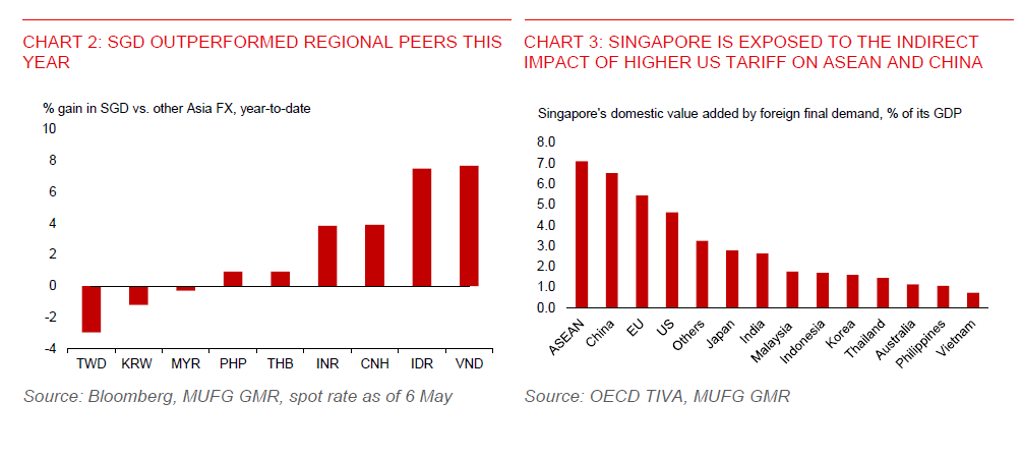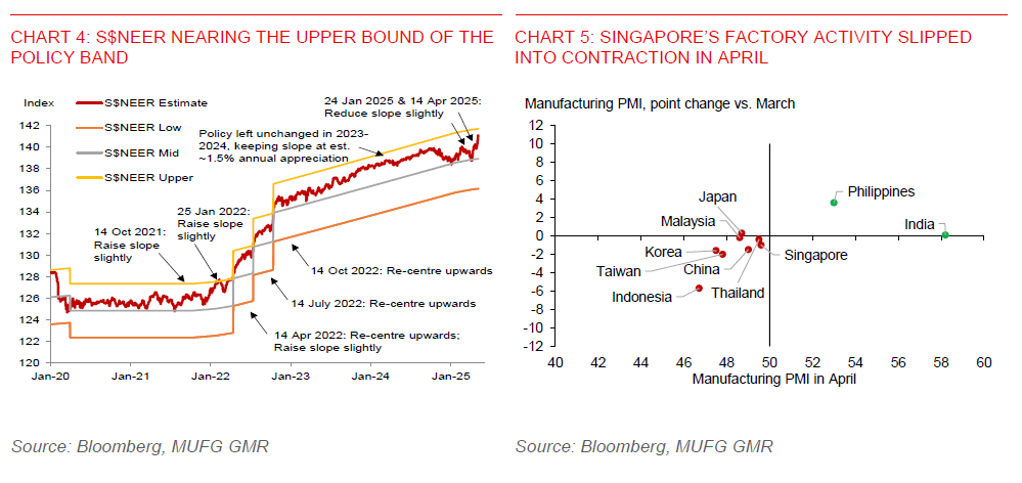Key Points
Please click on download PDF above for full report
- The Singapore dollar (SGD) has gained significantly against the US dollar this year, but we are cautious about extrapolating recent bout of SGD strength due to macro headwinds. The Singapore dollar has risen against the US dollar by more than 5% on a year-to-date basis, outperforming the Bloomberg Asia Dollar Spot Index (+3%) and most emerging Asian currencies. Potential trade talk between the US and China has likely fuelled this optimism. China’s Ministry of Commerce said on 2 May that it is evaluating a potential trade talk with the US.
- Singapore’s large dependence on exports means its economy will be affected by higher US tariffs. We have revised down our GDP growth forecast for Singapore to 1.5% in 2025, from 2.9% previously. Singapore’s domestic value-added in exports made up about 42% of its GDP, more than three times that of Indonesia (12.2% of GDP), which is a more domestic oriented economy in the Asia region. The top few destinations for Singapore’s export value-added were ASEAN (7.1% of GDP), China (6.5% of GDP), EU (5.5%) and US (4.6%).
- Singapore’s economy has been subjected to the 10% baseline US tariffs, which is apparently non-negotiable from the US perspective. While this is much lower than the reciprocal tariffs faced by regional peers. there will still be large indirect economic impact on Singapore via trade linkages with regional peers. We estimate the bulk of tariff impact will likely be from the negative spillover effects from US tariffs on regional peers. Notably, Trump has imposed 145% tariffs on most goods from China. He has also announced higher reciprocal tariffs on other countries on 2 April, only to pause them for 90 days until 9 July while imposing a 10% blanket tariff in the interim instead.
- With our estimate of Singapore’s S$NEER approaching the upper bound of the policy band, there is likely limited room for further sharp SGD appreciation in our view. Our S$NEER estimate has gained by about 1.7% since the MAS policy meeting on 23 January, despite the central bank loosening its exchange rate policy setting in both the January and April policy meetings. This implies the S$NEER is possibly trading at around 0.4%-0.5% below the upper bound of the policy band, which is not seen since 24 September 2024, when USDSGD was at a decade low of 1.2835. USDSGD subsequently rebounded sharply in Q4 2024.
- The MAS may further ease its exchange rate policy again in July to cap strength in S$NEER, at a time when Singapore’s exports are likely to show visible signs of deterioration while inflation stays modest. Singapore’s PMI fell to 49.6 in April from 50.6 in March, while the electronics sector PMI also points to a contraction in activity, falling to 49.8 from 50.9 in March. This presages more weakness in factory activity and a moderation in the tech cycle over the coming months.
- We forecast Singapore’s headline inflation to moderate to an average 0.9%yoy in 2025, from 2.4%yoy in 2024. Falling oil prices will contain imported costs. Domestically, wage growth will also likely slow, given the labour market will become less tight and the unemployment rate has crept higher. There are also downside risks to our inflation outlook. Notably, negative inflation momentum on a quarter-on-quarter basis only occurred twice in the decade before the Covid pandemic, one during the oil price slump in 2015, and the other during the trade war in 2019, which led to a cyclical slowdown in the domestic economy.
- On a positive note, domestic political stability will be a tailwind at a time of heightened global uncertainty. Singapore held its general election on 3 May, with the ruling People’s Action Pary returning to power with a strong mandate. Its national vote share rose to 65.6% from 61.2% in the 2020 general election. The PAP also won 87 (or 89.7%) of the 97 parliamentary seats, with the opposition holding on to the remaining. With all his key ministers being re-elected, Prime Minister Lawrence Wong now has a strong hand to assemble his cabinet members and chart a resilient path forward for the city-state.



